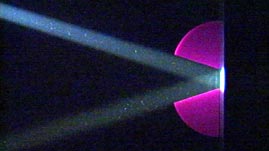Teachers' Domain - Digital Media for the Classroom and Professional Development
User: Preview

Source: Harvard—Smithsonian Center for Astrophysics
In this video segment adapted from Shedding Light on Science, learn about the reflection of light. Ball bearings are used to represent photons and illustrate the reflective property of light. A beam of light traveling through a water table demonstrates how two different surfaces—a mirror and a paper card—reflect light. Although light always follows the law of reflection, see how the seemingly smooth paper is actually rough and affects the way the light is reflected. Ray diagrams and a demonstration of ball bearings dropped onto smooth and rough tiles illustrate why reflected light is scattered from rough surfaces.
Light and the Law of Reflection (Audio Description) (Video)
Some objects are light sources that generate their own light, but most objects can only be seen if light reflects from their surfaces. For example, your hand does not produce light—if you were in a completely dark room, you could not see your own hand. However, in a lit room, the light from a lamp reflects off your skin and allows you to see your hand. Similarly, you can see your image in a bathroom mirror because light reflected from your body is then reflected from the surface of the mirror.
But what does it mean to say that light is reflected? In a given medium, light travels in a straight path. However, when light hits a boundary between two materials, the light changes direction. If the new material is opaque, the light travels back through the medium from which it came; it is reflected. If the new medium is transparent, some of the light may be reflected while some may be transmitted and undergo refraction (the bending of light).
The behavior of a ray of light at a boundary can be described by the angles made with respect to the normal line (a line perpendicular to the surface of reflection). For example, the angle of incidence is the angle between the incoming ray and the normal line. The angle of reflection is the angle between the outgoing reflected ray and the normal line. When light is reflected, its behavior follows the law of reflection, which states that the angle of incidence is equal to the angle of reflection.
Light is composed of a stream of particles—discrete packets of energy called photons, which have no mass. Because light always follows the law of reflection, photons maintain their orientation when reflected from a smooth, mirror-like surface. This type of reflection, called specular reflection, is why you can see your image in a mirror or even in a well-polished surface such as a freshly washed car or a pair of patent leather shoes.
However, when light is reflected from a surface that is not smooth at the microscopic level, diffuse reflection occurs. The photons still follow the law of reflection, but since the surface is rough, each individual photon hits the surface at a different angle. Therefore, the reflected photons all leave at different angles and the light is scattered in different directions. In this case, because the orientation of the incoming rays is not maintained, you cannot see a reflected image.
 Loading Standards
Loading Standards Teachers' Domain is proud to be a Pathways portal to the National Science Digital Library.
Teachers' Domain is proud to be a Pathways portal to the National Science Digital Library.
